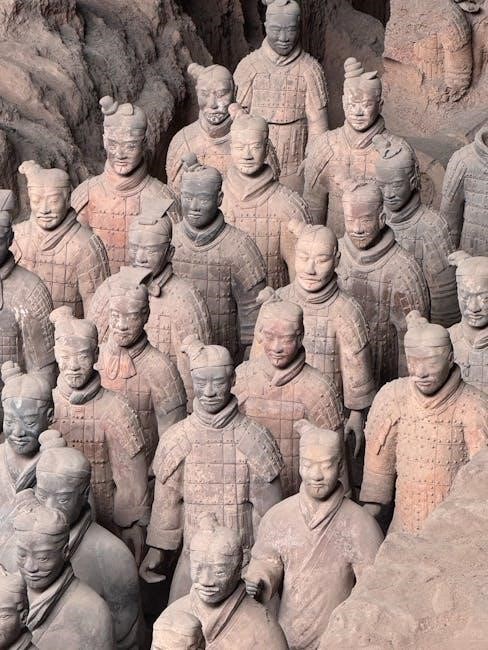The Salvation Army Valuation Guide 2023 provides donors with a comprehensive resource to determine the tax-deductible value of donated items, ensuring accurate and fair assessments for charitable contributions.
Overview of the Salvation Army Valuation Guide
The Salvation Army Valuation Guide 2023 is a detailed resource designed to help donors and volunteers accurately assess the value of donated items. It provides a comprehensive list of common items, such as clothing, furniture, and household goods, along with their estimated values based on condition, age, and market demand. This guide ensures transparency and fairness in determining tax-deductible values for charitable contributions.
By referencing market trends and industry standards, the guide offers a reliable framework for valuing donations. It also highlights factors like rarity, quality, and current demand, which can significantly impact an item’s value. This tool is essential for both donors seeking tax deductions and Salvation Army locations processing donations efficiently.
The guide is regularly updated to reflect changes in market values and IRS guidelines, ensuring it remains a trusted and up-to-date resource for everyone involved in the donation process. It simplifies the valuation process, making it easier for individuals to contribute confidently to The Salvation Army’s mission.
Why the Valuation Guide is Important for Donors
The Salvation Army Valuation Guide 2023 is crucial for donors as it provides clear and accurate valuations for donated items, ensuring they can claim the correct tax deductions. By offering detailed estimates based on item condition, age, and market demand, the guide helps donors avoid overvaluing or undervaluing their contributions. This transparency builds trust and confidence, encouraging more people to support The Salvation Army’s mission. Additionally, the guide aligns with IRS requirements, reducing the risk of audits and ensuring compliance. It also educates donors about the factors influencing item values, empowering them to make informed decisions. Ultimately, the guide simplifies the donation process, benefiting both donors and the organization.

Understanding the Salvation Army Donation Process
The Salvation Army’s donation process involves item collection, sorting, and valuation, guided by their 2023 Value Guide to ensure fair and transparent processing of contributions.
How the Salvation Army Determines Item Values
The Salvation Army determines item values using a detailed guide that considers factors like condition, age, rarity, and market demand. This guide helps donors estimate the fair market value of their contributions, ensuring transparency and fairness. The process involves categorizing items, assessing their quality, and referencing current market trends to assign accurate values. Donors receive a receipt with itemized values, which can be used for tax deductions. The Salvation Army also provides online resources and tools to help donors understand and calculate the value of their items. This systematic approach ensures that contributions are valued appropriately, supporting both donors and the organization’s mission.

Factors Affecting the Value of Donated Items
The value of donated items is influenced by several key factors, including condition, age, rarity, and market demand. Items in excellent condition typically hold higher value, while those requiring repairs or showing significant wear may be valued lower; Age and rarity also play a role, with vintage or unique items often commanding higher prices. Market demand is another critical factor, as popular or seasonal items may have greater value. Additionally, the original price and brand of an item can impact its valuation. The Salvation Army considers these factors to provide fair and accurate assessments, ensuring donors receive appropriate guidance for their contributions. These factors help determine the tax-deductible value, supporting both donors and the organization’s charitable efforts effectively.

Key Factors in Valuation
The key factors in valuation include condition, age, and market demand, which help determine the fair and accurate value of donated items effectively.
Condition and Quality of Items
Condition and quality significantly influence the valuation of donated items. Items in excellent condition, with minimal wear and tear, generally hold higher value. Functionality is crucial—non-working or damaged items may be deemed unsalable or valued lower. Cleanliness also plays a role, as soiled or stained items may be rejected. The Salvation Army assesses items based on their ability to be resold, ensuring they meet standards for reuse. Donors are encouraged to inspect items before donating to ensure they are in good, usable condition. This not only helps maximize the item’s value but also supports the organization’s mission effectively. Proper condition and quality ensure donations make the greatest impact, benefiting both recipients and donors alike.
Age and Rarity of Donated Goods
Age and rarity are critical factors in determining the value of donated goods. Items that are rare, limited edition, or historically significant often command higher valuations. Antiques, vintage clothing, and unique collectibles are prime examples. The Salvation Army considers these factors to assess market demand and potential resale value. Rare items may require professional appraisal to ensure accurate valuation. Donors are encouraged to provide documentation or provenance for rare or antique items, as this can significantly enhance their value. Understanding the balance between age and condition is key, as even rare items in poor condition may be less valuable. The Salvation Army’s expertise helps donors unlock the full potential of their unique contributions, supporting their charitable goals effectively.
Market Demand and Current Trends
Market demand and current trends significantly influence the valuation of donated goods. Items in high demand, such as sustainable or vintage clothing, often hold greater value. Conversely, items with low demand or outdated styles may be less valuable, regardless of their condition. The Salvation Army considers these factors to ensure fair and accurate valuations. For example, mid-century furniture or retro electronics may command higher prices due to their popularity among collectors. Seasonal trends also play a role, with winter coats or holiday decorations being more valuable during specific times of the year. Staying informed about current market trends can help donors understand the potential value of their contributions and maximize their impact.

Common Donated Items and Their Values
Common donated items include clothing, furniture, electronics, and household goods. The Salvation Army Valuation Guide provides estimated values based on condition, age, and market demand, aiding tax deductions.
Clothing and Accessories Valuation
Clothing and accessories are among the most frequently donated items. The Salvation Army Valuation Guide 2023 provides estimated values based on the item’s condition, age, and original price. Gently used clothing, such as shirts, pants, and dresses, typically ranges from $2 to $10 per item. Coats, suits, and formal wear may have higher values, up to $20 or more. Accessories like belts, hats, and scarves are valued between $1 and $5. Shoes, depending on condition, can range from $3 to $15 per pair. The guide emphasizes fair market value, ensuring donors receive accurate assessments for tax-deductible purposes. Clean, functional items in good condition are more likely to maximize donation impact.
Furniture and Household Goods Valuation
Furniture and household goods are valued based on their condition, age, and original price. The Salvation Army Valuation Guide 2023 suggests that items like sofas, chairs, and tables range from $20 to $100, depending on quality and usability. Gently used appliances, such as refrigerators or washing machines, may be valued between $50 and $200. Household items like lamps, dishes, or kitchenware typically range from $5 to $30. The guide emphasizes that items in good working condition with minimal wear command higher values. Donors are encouraged to consider fair market value, ensuring accurate assessments for tax purposes. Clean, functional furniture and household goods are highly appreciated and contribute significantly to the Salvation Army’s mission.
Electronics and Appliances Valuation
Electronics and appliances are valued based on their condition, age, and functionality. The Salvation Army Valuation Guide 2023 suggests that items like computers, smartphones, and televisions range from $20 to $100, depending on their working condition. Larger appliances, such as refrigerators or washing machines, may be valued between $50 and $200. The guide emphasizes that functional items with minimal wear or damage are more valuable. Donors should ensure items are clean and in good working order to maximize their value. The Salvation Army uses these donations to support community programs, making accurate valuation crucial for both donors and the organization. Always refer to the guide for specific valuation estimates.

Tax Considerations for Donations
The Salvation Army Valuation Guide 2023 helps donors determine tax-deductible values, ensuring compliance with IRS guidelines for charitable contributions and accurate fair market value assessments.
Tax-Deductible Values Explained
Tax-deductible values for donations to The Salvation Army are determined based on the fair market value of items, considering factors like condition, age, and original price. The 2023 Valuation Guide provides a detailed list of common donated items, such as clothing, furniture, and electronics, along with their estimated values. Donors can use this guide to accurately assess the value of their contributions for tax purposes. It’s important to note that only items in good condition and eligible for resale qualify for tax deductions. The IRS requires documentation, such as receipts and appraisals for high-value items, to support claimed deductions. Accurate valuation ensures compliance with tax regulations and maximizes the benefit of charitable giving.
How to Calculate Your Tax Deduction
To calculate your tax deduction for donations made to The Salvation Army using their 2023 Valuation Guide, follow these organized steps:
- Itemize Your Donations: Create a detailed list of all donated items, such as clothing, furniture, and appliances, noting their condition and category.
- Determine Fair Market Value: Use the Salvation Army’s guide to find the estimated value of each item based on its condition, age, and original price.
- Obtain Documentation: Keep the receipt provided by The Salvation Army, which lists the donated items. For high-value items, consider getting an appraisal.
- Sum the Values: Add up the values of all donated items. Group similar items together for ease, such as valuing all clothing as a single category.
- Report on Tax Forms: Use IRS Form 8283 for non-cash charitable contributions to report the total value of your donations.
- Check Deduction Limits: Verify the IRS limits on charitable deductions, typically a percentage of adjusted gross income, and plan accordingly.
- Consult Resources: Utilize The Salvation Army’s online tools or PDF guides for precise valuations and ensure compliance with IRS guidelines.
- Seek Professional Help: If unsure about any part of the process, consult a tax professional to maximize deductions and avoid errors.
- Meet Deadlines: Complete the calculation and documentation well before the tax filing deadline to ensure eligibility for deductions.
By following these steps, you can accurately calculate your tax deduction, ensuring compliance and maximizing the benefit of your charitable contributions.

Special Items and Their Valuation
The Salvation Army Valuation Guide 2023 offers insights into assessing unique donations like antiques, collectibles, books, media, and vehicles, ensuring accurate valuations based on condition, rarity, and market demand.
Antiques and Collectibles Valuation
Antiques and collectibles are unique items requiring special consideration in valuation. The Salvation Army Valuation Guide 2023 helps determine their worth based on factors like condition, rarity, and historical significance. Condition plays a crucial role, as damage or wear can significantly impact value. Rarity is another key factor, with limited editions or one-of-a-kind pieces often commanding higher values. Additionally, market demand and current trends influence appraisals. For high-value or rare items, professional appraisals may be necessary to ensure accurate valuations. Donors are encouraged to research or consult experts to determine fair market values. The guide also provides general estimates for common collectibles, helping donors make informed decisions about their contributions.
Books and Media Valuation
Books and media items, such as DVDs, CDs, and vinyl records, are commonly donated and valued based on their condition, age, and demand. The Salvation Army Valuation Guide 2023 provides estimates for these items, considering factors like rarity and popularity. Hardcover books in excellent condition may hold higher value, while paperback books are typically valued lower. Media items, such as DVDs and CDs, are assessed based on their current market demand. Textbooks and educational materials are valued differently than fiction or entertainment media. Donors should note that items must be in good, usable condition to qualify for tax deductions. The guide offers general ranges to help donors estimate fair market values for their contributions.
Vehicles and Large Appliances Valuation
Vehicles and large appliances are valued based on their condition, functionality, and market demand. The Salvation Army Valuation Guide 2023 provides specific ranges for these items, ensuring fair assessments. Vehicles, including cars, trucks, and motorcycles, are typically valued using industry standards like Kelley Blue Book, considering factors like mileage, make, and model. Large appliances, such as refrigerators, washers, and dryers, are assessed for their working condition and age. Donors are encouraged to provide detailed information, including make and model, to help determine accurate values. These items must be in good working condition to qualify for higher valuations. The guide helps donors understand the potential tax-deductible value of their contributions, supporting both charitable giving and compliance with tax regulations.

Maximizing the Impact of Your Donation
Maximizing your donation’s impact involves selecting high-demand items and timing contributions strategically. The Salvation Army Valuation Guide 2023 helps donors align their gifts with community needs effectively.
Choosing the Right Items to Donate
Choosing the right items to donate is crucial for maximizing your contribution’s impact. The Salvation Army Valuation Guide 2023 helps donors identify items in high demand, such as gently used clothing, furniture, and household goods. Assessing the condition and quality of your items ensures they can be sold or repurposed effectively. Consider the needs of your local community and align your donations accordingly. Avoid donating broken or outdated items, as they cannot be sold and may incur disposal costs. By selecting items that are in good condition and align with current needs, you enhance the value of your donation and support The Salvation Army’s mission more effectively. Always check local guidelines for specific acceptance criteria.
Timing Your Donation for Maximum Impact
Timing your donation strategically can significantly enhance its impact. Consider donating during periods of high demand, such as natural disasters or holiday seasons, when needs are greatest. Donating seasonal items, like winter coats in colder months, ensures they reach those in need promptly. Additionally, donating during sales tax holidays can increase the value of your contribution. The Salvation Army often experiences higher demand for certain items at specific times of the year, so aligning your donation with these periods maximizes its utility. Moreover, for tax purposes, donations made by year-end can provide deductions for the current tax year. By thoughtfully timing your donation, you can ensure it makes the greatest difference in your community while supporting The Salvation Army’s vital programs.

Additional Resources and Guides
The Salvation Army offers a downloadable Valuation Guide PDF and online tools to help donors accurately assess item values, ensuring transparency and ease in the donation process.

Salvation Army Donation Value Guide PDF
The Salvation Army Donation Value Guide PDF is a detailed resource that helps donors determine the tax-deductible value of their contributions. It includes item categories like clothing, furniture, electronics, and more, providing approximate values based on condition and market demand. This guide ensures transparency and fairness in valuation, making it easier for donors to understand how their items are assessed. It also offers tips for accurately estimating values and includes information on tax deductions. Available for download on The Salvation Army’s official website, the PDF guide is a convenient tool for planning donations and maximizing their impact. It’s updated annually to reflect current market trends and IRS guidelines, ensuring donors have the most relevant information at hand.
Online Tools for Valuing Donations
Online tools like TurboTax’s ItsDeductible and Goodwill’s donor guide help estimate the value of donated items. The Salvation Army also offers an online valuation estimator to assist donors in determining fair market values. These tools allow users to input item details, such as condition and category, to receive an estimated value. They are particularly useful for common items like clothing, furniture, and electronics. Donors can also access the Salvation Army’s official website for downloadable resources, including the Donation Value Guide PDF. While these tools provide convenient estimates, donors should consult multiple sources to ensure accuracy, especially for unique or high-value items like antiques or collectibles. Using these tools can streamline the donation process and help maximize tax deductions.
The Salvation Army Valuation Guide 2023 empowers donors with transparency and confidence, ensuring accurate assessments and meaningful contributions that support vital community programs while offering tax benefits.
Final Tips for Using the Valuation Guide
When using the Salvation Army Valuation Guide 2023, ensure items are in good condition and research market trends for accurate valuations. Keep detailed records of donations, including photos and receipts, to support tax claims. For unique or high-value items like antiques, consult professionals for appraisals. Timing donations strategically, such as during peak demand seasons, can maximize their impact. Consider the specific needs of your local Salvation Army to tailor your contributions effectively. Finally, always double-check the guide’s updates and use online tools for the most current valuations. Accurate and thoughtful use of the guide ensures your donations make the greatest difference while complying with tax regulations.
The Importance of Accurate Valuation
Accurate valuation of donated items is crucial for ensuring compliance with tax regulations and maintaining the integrity of charitable contributions. The Salvation Army Valuation Guide 2023 helps donors and organizations assign fair market values, avoiding overestimation or underestimation. Proper valuation ensures transparency and accountability, which are essential for building trust between donors and The Salvation Army. It also helps donors claim the correct tax deductions, preventing potential legal issues. Additionally, accurate valuations allow The Salvation Army to allocate resources effectively, maximizing the impact of donations. By adhering to the guide, donors contribute to a fair and efficient process that benefits both individuals and the community. Precise valuation is key to maintaining the organization’s reputation and operational success.
